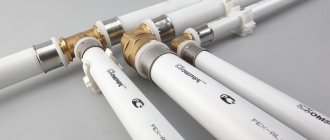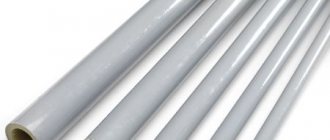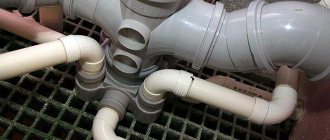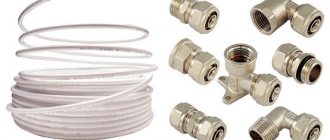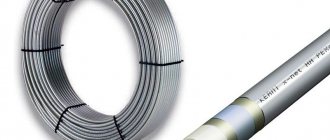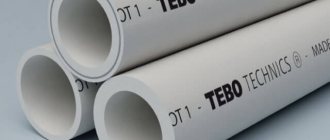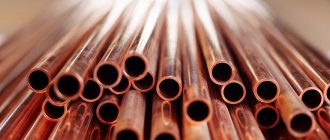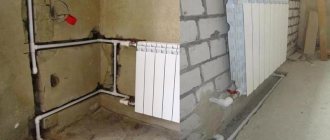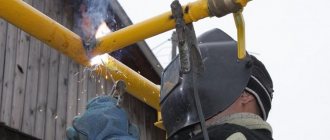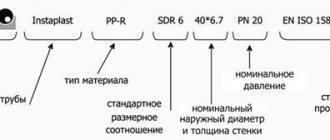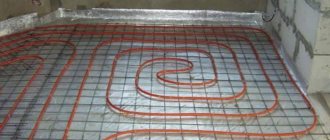The widespread use of metal-plastic pipes in domestic water supply and heating systems has become possible thanks to a unique design that combines the positive features of metal and plastic pipes at the same time.
Metal-plastic pipes - the technical characteristics of which, despite the popularity of the products, are not familiar to everyone, are distinguished by high anti-corrosion properties, flexibility and remain just as durable. In this article we will give a more detailed description of metal-plastic pipes, describe their structure and features of use.
Metal-plastic pipes and fittings for their connection
Construction of metal-plastic pipes
Composition of metal-plastic pipes
The base of a metal-plastic pipe is the inner layer of polyethylene, which gives the pipe strength and performs a load-bearing function.
A layer of aluminum foil is attached to it using an adhesive composition, which prevents the diffusion of oxygen and stabilizes the pipe.
The edges of the foil are butt welded together with a laser. Metal-plastic pipes are stabilized by their linear expansion temperature, which becomes comparable to the expansion temperature of metal pipes. At the same time, the outer white polyethylene layer has a decorative and protective function.
The general design of the pipes is as follows:
- polyethylene layer;
- layer of glue;
- aluminum layer;
- another layer of glue;
- outer layer of polyethylene.
Thanks to this unique design, the service life of metal-plastic pipes is very long.
With all this, each structural layer of a metal-plastic pipe has its own separate function. Thus, cross-linked polyethylene, which makes up the inner layer, provides the inner surface with the necessary smoothness, protecting it from overgrowing with scale and other types of deposits.
Both polymer layers protect the aluminum core from the formation of galvanic couples with steel and brass pipeline elements, reduce the thermal conductivity of the pipes and the intensity of condensation formation on them.
Metal-plastic pipe design
Forms of production of metal-plastic pipes
The outer diameters of metal-plastic pipes produced by modern manufacturers range from 16 to 63 mm. The most common diameters are 16, 20, 26 mm; sometimes, when creating extensive wiring for large houses, diameters of 32 and 40 mm are also used.
For plumbing in an ordinary apartment, a metal-plastic pipe with a diameter of 16 or 20 mm is quite suitable. For example, the main pipe distribution can be formed from products with a diameter of 20 mm, while pipes with a diameter of 16 mm can be used for branches to the bathtub, mixers and other household appliances.
Advice!
The cost of fittings for pipes with a diameter of 20 mm is significantly more expensive compared to the connecting elements of 16 mm pipes.
Therefore, at normal pressure in the central system, it is quite possible to use 16 mm pipes and corresponding fittings without any damage.
The pipes are supplied in the form of coils, the dimensions of the metal-plastic pipes in which range from 50 to 200 m in length.
Metal-plastic pipe: the pipe dimensions can be almost any, since coils sometimes accommodate pipe lengths of up to 200 m
Dimensions
The most popular standard sizes of metal-plastic pipes are presented in the table:
Diameters of metal-plastic pipes
Metal-plastic pipes with a diameter of 16 mm to 25 mm are used, as a rule, for intra-apartment wiring. Metal-plastic pipes with a diameter of 32 mm and 40 mm are used for the installation of public water supply systems.
Metal-plastic pipes are also produced in other diameters (50 mm, 63 mm), but they are less in demand.
It is not difficult to select fittings for metal-plastic pipes, since the size range of manufactured fittings for metal-plastic pipes corresponds to the sizes of the pipes being produced.
Advantages and disadvantages of metal-plastic pipes
As already mentioned, metal-plastic pipes have absorbed technical characteristics and positive qualities from each of the materials used in their production.
Advantages of metal-plastic pipes
As a result, the following list of advantages was achieved:
- Resistance to silting and overgrowing.
- Corrosion resistance and anti-toxicity.
- High throughput, which is 1.3 times greater compared to metal pipes of the same diameter.
- Resistance to aggressive environments.
- Reliability and durability. For example, a steel pipe will last about 15-20 years, but if you take metal-plastic pipes, the service life of the pipeline will be about 50 years.
- Low weight and high ductility.
- Low thermal conductivity: 175 times less than steel pipes and 1300 times less than copper pipes.
- Easy installation of metal-plastic pipes with your own hands, minimal amount of waste, a simple list of tools for processing, the ability to pour pipes into concrete without restrictions.
- Good sound insulation properties.
- Antistatic (non-conductivity of stray currents).
- Excellent maintainability without the need for pipe bending and welding equipment.
- Aesthetic appearance that does not require painting.
Disadvantages of metal-plastic pipes
With all their advantages, metal-plastic pipes are not without their disadvantages. Metal and plastic have different expansion coefficients, so constant changes in liquid temperature in pipes can lead to weakening of the joints of metal-plastic pipes, which can cause leaks.
Advice!
This feature must be taken into account when laying pipes: they should be laid with some reserve (not stretched).
In places where pipes bend, it is necessary to provide compensation loops.
Bending a metal-plastic pipe using a special spring
In addition, a metal-plastic pipe - the bending characteristics of which are also determined by the materials used in its manufacture, being quite plastic, is afraid of repeated bends and accepts bending only within certain radii using special pipe benders.
You can bend the pipe manually, but before doing this you will need to insert a special spring into it and fill the pipe with sand. Regardless of the bending method, the pitch of the bends on the pipe should not be less than 50 mm. Also, twisting of pipes relative to their central axis is not allowed.
Areas of application of metal-plastic pipes
In addition to widespread use in everyday life, the qualitative characteristics of metal-plastic pipes allow them to be used in a whole list of different areas:
- For the transportation of liquid and gaseous agents in various fields of industry, agriculture and transport.
- In systems transporting compressed air.
- When installing air conditioning systems.
- For protection and shielding of electrical power and other wires.
The polyethylene used in the production of metal-plastic pipes does not contain harmful impurities, making the products quite suitable as elements of drinking water supply systems.
Household water supply made of metal-plastic pipes
There are also limitations in the use of metal-plastic pipes.
So, they cannot be used in the following cases:
- When installing central heating systems with elevator units.
- In premises that have been assigned category “G” according to fire safety standards.
- If liquid is supplied to pipes at an operating pressure of more than 10 bar.
- In places where there are sources of thermal radiation with a surface temperature of over 150 degrees.
Advice!
Metal-plastic pipes, among other things, should not be used in safety, expansion, signal and overflow pipelines, as well as in fire-fighting water supply systems.
Which pipes are better?
Metal-plastic pipes made of cross-linked polyethylene
For the installation of heating systems, metal-plastic pipes made of cross-linked polyethylene or polyethylene with increased heat resistance, reinforced with fiberglass or aluminum, are suitable.
Metal-plastic pipes made of cross-linked polyethylene are suitable for installing a water supply system transporting drinking water and installing hot water supply systems. The markings on metal-plastic pipes used for the installation of a drinking water supply system must indicate that they are suitable for the installation of a water supply system transporting drinking water.
The most popular metal-plastic pipes on the domestic market are: Italian, Belgian, German, Oventrop, Kermi, Finnish, French.
Technical characteristics of metal-plastic pipes
Next, the technical characteristics of metal-plastic pipes will be presented using the example of the most popular pipes with a diameter of 16 and 20 mm:
- The wall thickness of metal-plastic pipes with diameters of 16 mm and 20 mm is 2 and 2.25 mm, respectively, while the thickness of the aluminum layer in them is 0.2 and 0.24 mm.
- The weight of one linear meter of 16 mm pipe is 115 g, 20 mm - 170 g.
- The volume of liquid in 1 linear meter of a 16 mm pipe is 0.113 l, 20 mm - 0.201 l.
- Regardless of what diameter of metal-plastic pipes is used, the expansion coefficient of metal-plastic will be 0.26x10-4 per ºC, the roughness coefficient will be 0.07, and the thermal conductivity coefficient will be 0.43 W/m*K.
- The strength of the adhesive joint and welded joint of aluminum is 70 N/10 mm and 57 N/mm2, respectively.
- The transverse tensile strength indicator is 2880 N.
- The minimum bending radii of pipes manually and using a pipe bender are 80 and 45 mm, respectively.
- The oxygen diffusion rate during pipe operation is 0 g/m3.
Graph illustrating the service life of various types of pipes depending on operating pressure
Separately, we should talk about what pressure and what temperature metal-plastic pipes can withstand.
When the pressure in the pipeline is 10 bar, the optimal (operating) temperature ranges from 0 to 95 degrees.
If a liquid pressure of 25 bar is supplied to metal-plastic pipes, the operating temperature goes within 0...+25 degrees. The maximum short-term temperature of the working environment that a metal-plastic pipeline can withstand without loss of integrity is 110 degrees.
The maximum operating pressure under pipe operating conditions at the maximum permissible operating temperature is 10 bar.
The pressure at which the integrity of the pipe is broken at a working medium temperature of 20 degrees is 94 bar.
Metal-plastic pipes – in which the pressure and temperature remain unchanged, are capable of operating without destruction under the following conditions:
- At a temperature of -20 degrees for an hour - at a pressure of at least 5.71 MPa.
- At a temperature of -95 degrees for an hour - at a pressure of at least 3.3 MPa.
- At a temperature of -95 degrees for 100 hours - at a pressure of at least 2.93 MPa.
- At a temperature of -95 degrees for 1000 hours - at a pressure of at least 2.57 MPa.
Reliability
Metal-plastic pipes can withstand a constant operating temperature of 95º, short-term temperatures of 110º.
Metal-plastic pipes can withstand a pressure of 10 bar, at an operating temperature of the transported substances of 95º; pressure of 25 bar, at an operating temperature of transported substances of 25º.
Metal-plastic pipes can be used when installing closed-type systems, i.e. brick up, but subject to access to detachable elements of the pipeline. For example, you can install a “warm floor” system made of metal-plastic pipes under a concrete screed.
The connection of metal-plastic pipes is carried out only using compression or press fittings.
Features of marking metal-plastic pipes
Marking of metal-plastic pipes is applied so that the consumer can obtain information about the pipe and its operating conditions.
For different pipe manufacturers, the sequence of values in the marking code may be different, but in most cases it looks like this:
- The pipe manufacturing company is indicated.
- Next, indicate the certificate of conformity according to which the pipes are produced.
- Then the design features of the pipe are indicated - material, stitching method, protection from UV radiation, etc. The values PP-R, PE-R, PE-X indicate that the pipes are made of polypropylene, polyethylene or cross-linked polyethylene, respectively. Cross-linking methods are indicated in small Latin letters and mean: a – pyroxide method, b – using silane, c – through a flow of directed electrons, d – by the method of azo compound of molecules.
Metal-plastic pipes: diameter and other designations on pipe markings
- The next thing that is applied to metal-plastic pipes is the characteristics of the diameter and wall thickness. The diameter is indicated by numbers in millimeters within the range of 10-1200mm. In rare cases, there are metal-plastic pipes - the diameters of which are marked in inches.
- After this, the nominal pressure, expressed in bar and kgf/cm2 (PN), is entered into the marking code. It expresses the value of continuous water pressure in a pipe at an ambient temperature of 20 degrees, at which the service life will be 50 years without the need for repairs.
- The following is the designation of the medium suitable for transportation. Do not use aggressive media in drinking water pipes.
- At the end, the date of manufacture and batch number of the pipe are indicated.
Advice!
When laying metal-plastic pipes, be sure to leave the pipe markings visible so that, if necessary, you can easily determine which pipes were used.
A metal-plastic pipe, the characteristics of which were discussed in this article, is truly an almost irreplaceable element of any household pipeline. Perhaps these pipes are the most popular among other plastic modifications today.
Did you like the article? Subscribe to our Yandex.Zen channel
More information about metal-plastic pipeline
The listed strengths and weaknesses give only a general impression of this material. To ensure that there are no gaps left, it makes sense to take a closer look at metal-plastic water pipes.
The structure of a metal-plastic pipe, its types
The key difference between a metal-plastic pipeline and a metal or propylene pipeline is that it consists of separate layers glued together. This is both its advantage and disadvantage.
In cross-section, the metal-plastic pipe will consist of 5 layers. In the center there is a layer of aluminum foil (the ease of bending and the strength of the wall depend on its thickness). On both sides of the foil during production, it is coated with an adhesive composition and a layer of cross-linked Pex-b polyethylene is glued to it (inside and outside).
Structure of a metal-plastic pipeline
Note! The optimal foil thickness can be considered to be about 0.3 – 0.5 mm. In this case, installing a water supply system from metal-plastic pipes will not cause any particular difficulties; they will bend easily, while maintaining sufficient strength.
The described wall structure is the same for all metal-plastic pipelines, and the differences lie mainly in the method of cross-linking polyethylene, the material used, operating pressure, etc.
All this data can be obtained simply by looking at the pipeline markings:
- polypropylene (PP-R), polyethylene (PE-R) and cross-linked polyethylene (PE-X) can be used;
- The crosslinking method is marked as follows: a – pyroxide; b – using silane; c – using the energy of a directed electron beam; d – using nitrogen. The price of pipelines does not differ much depending on the method used;
- operating pressure;
- further it is indicated what exactly can be transported (drinking water, technical liquids, etc.);
- at the end there is a batch number.
Labeling example
As for standard sizes, the most popular diameters can be considered 16, 20, 26, 32, 40 and 50 mm. In this case, the wall thickness varies from 2 mm (for diameters 16 and 20 mm) to 5 mm (for diameter 50 mm).
The internal diameter of metal-plastic pipes for water supply can be determined by subtracting double the wall thickness from the external diameter. To distribute water throughout an apartment, pipes with a diameter larger than 32 mm are usually not used.
Characteristics of popular diameters of metal-plastic pipelines
Connection methods
While soldering can be used with polypropylene pipes, a metal-plastic pipeline is usually laid using either press fittings or compression fittings. Only the technology is slightly different; water fittings for metal-plastic pipes are made of metal (brass).
Types of fittings
The order of work when connecting pipes is slightly different:
- in the case of press fittings, a sliding sleeve and a flaring machine are used; such a joint belongs to the class of one-piece joints. Also, the connection can simply be crimped;
- Compression fittings can be disassembled if desired, but experts advise changing the entire fitting. That is, it can be conditionally classified as detachable.
Connection using compression fittings
Another feature of connecting metal-plastic pipes is that it is better to leave the joints open. Even if the technology has been followed, the risk of leakage still remains.
Technology of work execution
As for how to connect metal-plastic water pipes, it is difficult to give preference to any one method, so we will consider both.
In the case of using compression fittings, work is performed in the following order:
- After marking, the pipe is cut and burrs are removed. Also, the end of the pipe is chamfered and calibrated to restore the geometry of the section;
Note! It is better to use special scissors or a cutter for cutting. Of course, you can cut it with a regular metal saw, but there is a risk of deforming the pipe.
For cutting it is better to use a special cutter
- the fitting is lubricated, a union nut and a split ring are put on the pipe (in that order);
- a prepared pipe is placed on it. For the tightness of the joint, it is very important that the end of the tube is adjacent to the side of the fitting;
- After this, the union nut is pulled on and tightened first with your hands and then with a wrench. It is important not to overtighten the connection; if you don’t have a torque wrench at hand, you can be guided by the fact that when the nut is tightened all the way, approximately 1-2 threaded threads should remain visible. Do-it-yourself water supply made from metal-plastic pipes, taking into account the listed installation rules, is guaranteed to last a long time.
If a press connection is used, then you only need press pliers. The tube is inserted into the fitting until it stops (you can use the control windows as a guide). Then the metal part of the fitting is pressed using press pliers and the tightness of the connection is guaranteed.
The joint is pressed using press pliers
In the case of a push-on fitting, the instructions look like this:
- the pipe is prepared in the manner described above;
- The sliding part of the fitting is put on the pipe, and the pipeline is flared;
- then it is put on the fitting all the way;
- After this, the sliding part is pushed onto the tube using special pliers. Due to very strong compression, a tight connection is achieved.
Scheme for using a push-on fitting
